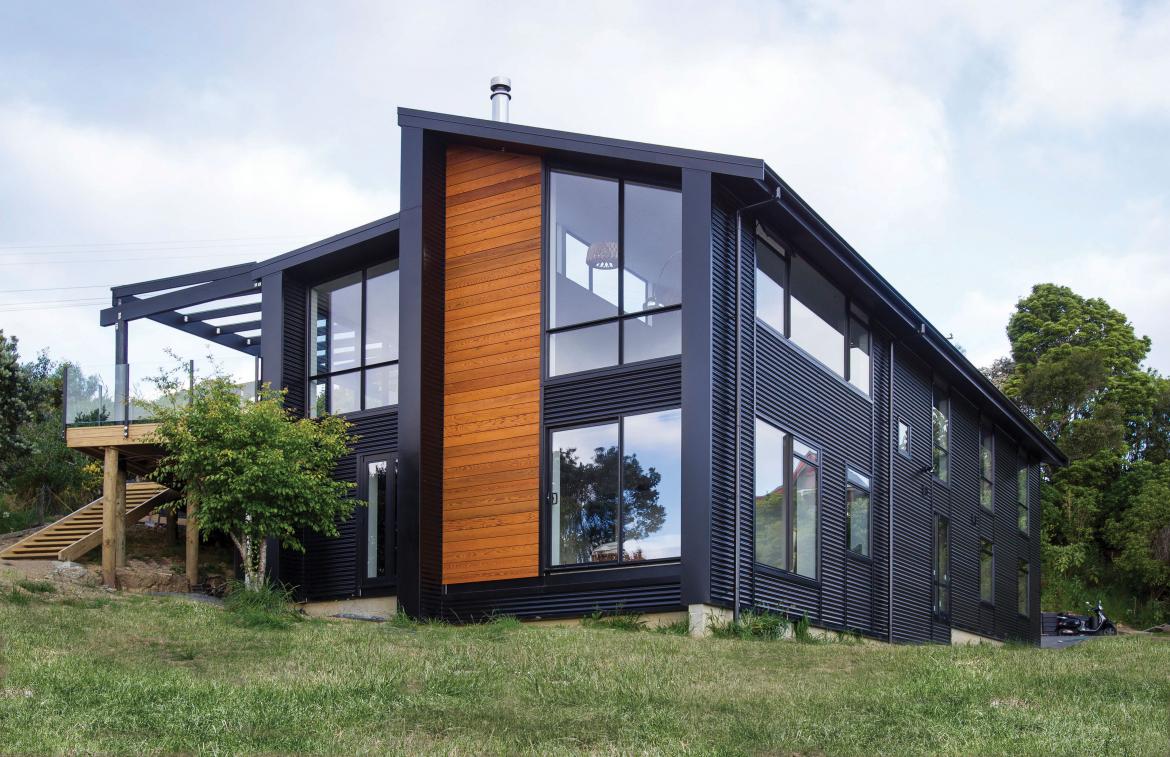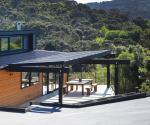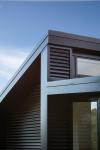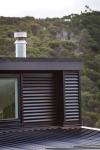Building in the Bush

Building a home takes huge amounts of optimism and fortitude, especially when you are working parents with two pre-schoolers to look after while overseeing and helping with the construction of a bespoke home.
That was the task facing Michele Powles and husband James after they sold their home, intended to buy a larger home for their young family but then decided to build on a sloping, south-facing site in West Auckland with views of the Manukau Harbour.
After they bought the section they had a false start with one architect before getting architect Glyn Bilkey on board for the project.
Michelle says they wanted to create a family home that was as sustainable and energy-efficient as they could afford. So they opted for a two-storey layout that captured the views to the south as well as bringing sun into the house from the other aspects.
They wanted a house designed for passive solar gain that was well insulated and well ventilated – and future-proofed as the family matured.
The layout of the home features the master bedroom, en suite and walk-in wardrobe on the western end of the ground floor with the eastern end of the house occupied by the garage. The staircase and laundry sits between the two wings.
Upstairs, there are three bedrooms and the main bathroom on the eastern side, with kitchen, dining and lounge at the western end. The lounge sits on the southern side and is warmed by a highly efficient firebox. The dining and kitchen area sit on the northern side with the dining space opening to a deck covered with Clearvue panels.
Glyn says he arranged the layout of the home across the sloping section to optimise the views and sun.
“Because the views are to the south, we had to frame the views rather than just doing all glass on that side,” he says. “They were keen on passive solar heating of their solid concrete floors so the windows have been placed to heat up the floors, including the clerestory windows, which can also be used as a heat stack for ventilation.”
To accommodate those north-facing clerestory windows, Glyn had to design the home with two roof planes – a steeper south-facing roof and a lower-pitched north-facing roof. Due to the lower pitch of five degrees on the northern plane, standard corrugate couldn’t be used so the couple opted for the strong profile of Dimond’s Veedek.
In keeping with the couple wanting a low cost, low-maintenance home, they chose Dimond Corrugate in ColorCote MagnaFlow for the cladding with some cedar weatherboard accents.The Dimond Corrugate in ColorCote MagnaFlow was chosen for its resistance to sea spray off the harbour and the ease with which it can be washed down to maintain the pre-painted surface.
Due to the “cost implications” of building on a sloping site, Glyn had to use his design nous to give the couple as much home as possible.
He came up with a self-buttressing structure to form the base of the house. The ground floor is a solid concrete box with a concrete slab on the bottom, concrete block walls and a suspended solid concrete ceiling. These insulated concrete floors not only give the home its structural strength but also provide the thermal mass to keep the home warm.
Glyn’s design also used thicker timber framing upstairs - 140mm versus the standard 90mm – which allowed for better insulation: R5.2 in the ceilings and R3.2 in the walls. The concrete walls downstairs were insulated inside and out, and the home has a weatherproofing and airtightness membrane system.
With a heat exchanger and ventilation system installed, as well as hot water heat pumps, this makes for a comfortable and energy-efficient environment.
Michele says James, an industrial scientist, contributed a lot of technological expertise to the build on top of the couple rolling up their sleeves to keep labour costs down.
“He had just finished a big commercial laboratory build so he had done a lot of research for that.”
Michele says there were compromises along the way but she got what she wanted with a standalone bath downstairs with a view, and James insisted on having a garage/workshop that came in handy as a work room/storage area during the build, particularly when the rain pelted down as it is wont to do in the Waitakere Ranges.
She adds, “We were going to add a fourth bedroom at a later date but we were told it would be more expensive to do it that way so we included it and just had to make the top floor a bit smaller to fit our budget. ”
That fourth bedroom has a fold-down bed so it can be used as a guest room or rumpus room.
Michele, a writer, had hoped to have a third floor office but that idea was dropped in the face of the cost involved. Instead, a separate office of 10sqm was built in a similar style to the home with the same Dimond cladding and roofing.
Michele, who has written a column for the Stuff website on the build as well as a blog about it at www.buildingboxes.co.nz, says all the research, dramas and compromises have been well worth it. Although she is not sure she would want to do it again.
“The children are really enjoying having their own house and it was great to come back to when we went away over Christmas,” she says. “It’s a beautiful spot with bush views and sea views and you can see the weather roll in.”




